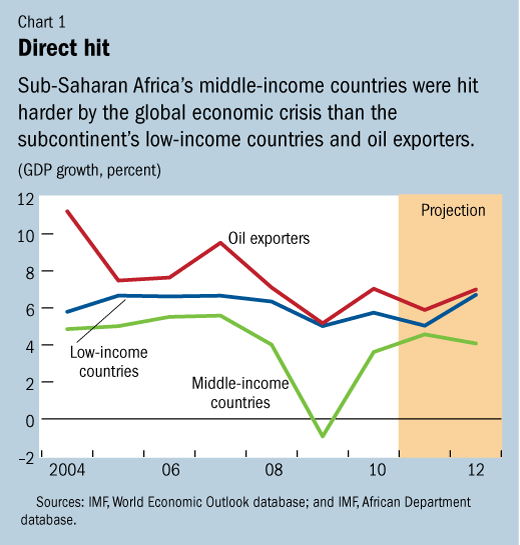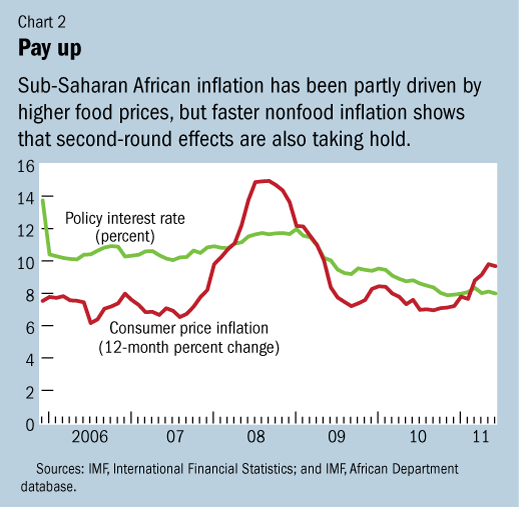REGIONAL ECONOMIC OUTLOOK

Typical street scene in Santa Ana, El Salvador. (Photo: iStock)
IMF Survey: Africa Set for Steady Growth, With Threat of Faster Inflation
October 19, 2011
- Sub-Saharan Africa set to maintain growth pace in 2012, but risks higher
- Emerging inflationary pressures warrant decisive action by policymakers
- Focus of fiscal policies should shift from short- to medium-term considerations
Economic growth in sub-Saharan Africa is set to maintain pace in 2012, supported by higher commodity prices and rising export demand, the IMF’s latest forecast for the region said.

Crane loads cocoa shipment in Abidjan, Cote d’Ivoire: strong commodity prices are helping to support growth in sub-Saharan Africa (photo: Luc Gnago/Reuters)
In many of Africa’s low-income countries, growth is also being boosted by domestic demand and by adding value to exports.
But the IMF’s Regional Economic Outlook for sub-Saharan Africa also cautioned that consumer price inflation is speeding up across the region, and that tighter monetary policy may be needed in some countries to head off inflation expectations. Fiscal policy may need to support tighter monetary conditions by focusing more on the medium term, the report said.
The outlook, released October 19, estimates that sub-Saharan Africa will grow by 5¼ percent in 2011 and 5¾ percent in 2012. However, this projection assumes that the global economy will regain some of its momentum in the coming months. If not, then Africa will not be immune and growth could falter.
In background studies published in the outlook, the IMF also highlights the quality and breadth of the region’s recent growth episode. These studies point to rising consumption of the poorest households, especially in countries where growth has been sustained at high levels, and the opportunities for intensifying trade with new growth markets.
Export-led growth
Supportive monetary and fiscal policies helped the region weather the 2009 global crisis in 2009 and set it on a recovery path for 2011 and 2012. Economic activity has also been driven by higher commodity prices and increased export demand, although to a varying extent across country groupings.
In many of sub-Saharan Africa’s low-income countries, growth is being supported by buoyant domestic demand along with export diversification into higher–value added production and to fast-growing emerging markets. However, higher food and fuel prices are bringing considerable difficulties, especially for the urban poor, and drought in the Horn of Africa is imposing untold hardships on households in that region.
For oil- and other resource-exporting countries, strong commodity prices are helping to support growth, the terms of trade, and foreign exchange reserves. For example, oil exporters are expected to grow b y 6 percent in 2011 and 7 percent in 2012, above the regional average.

The picture is less rosy for some middle income countries, including South Africa, which have been more exposed to recent global economic and financial turmoil. The middle income countries are expected to grow by 4–4½ percent in 2011 and 2012 (see Chart 1).
Inflationary pressures
One of the region’s main policy challenges is the steady increase in consumer price inflation to an average of 10 percent in June 2011 against 7½ percent in June 2010. Although inflation has been driven in part by higher food prices, accelerating nonfood inflation indicates that second-round effects—such as claims for higher pay—are also taking hold. In many countries, exchange rates are also coming under significant pressure.

Only a handful of countries have so far adjusted monetary policy in response to faster inflation and, even then, not decisively: in most cases, interest rates are little changed from the levels they were lowered to during the global financial crisis. Especially in countries that are running at close to capacity or where there have been serious signs of policy slippage, monetary policy needs to be tightened decisively to reduce the risks of entrenching inflationary expectations and creating unsustainable macroeconomic imbalances (see Chart 2).
Fiscal policy shift
Fiscal policy will play an important role in supporting monetary policy to avoid overheating and the possible reversal of several years’ hard-won gains in sub-Saharan Africa. In the many countries where output is close to potential, the focal point of fiscal policy needs to shift to medium-term considerations from the near-term accommodative stance that prevailed during the global slowdown.
In its outlook for the region, the IMF underlines the importance of aligning fiscal policy with financing and debt sustainability considerations, and draws attention to countries’ absorptive and project execution capacities. For middle-income countries and others where growth is expected to be more subdued, and where output and employment are still below their pre-crisis levels, there is a strong case for maintaining a supportive policy stance provided there are no binding financing constraints.
In spite of promising growth prospects for the region, the outlook said a note of caution is warranted in the event that downside risks to the global economy materialize. Indeed, the biggest threat to economic activity in the region is the strong possibility that already lower growth projections for advanced economies for 2011–12 will be revised down again.
Countries’ policy responses to a renewed global slowdown will depend on which policy buffers they still have available: for example, those without financing constraints should maintain spending even if revenues weaken, while there may be scope to ease monetary policy in countries that are not facing severe inflation or exchange rate pressures.







